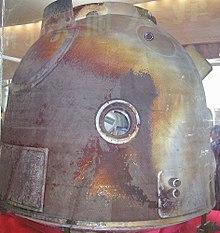Shenzhou (spacecraft)
[3] 神舟 is a pun and neologism that plays on the poetic word referring to China, 神州,[3] meaning Divine realm,[4] which bears the same pronunciation.
[5] Although China successfully launched an uncrewed satellite in 1970, its crewed spacecraft program was cancelled in 1980 due to a lack of funds.
China signed a deal with Russia in 1995 for the transfer of Soyuz technology, including life support and docking systems.
[citation needed] The first uncrewed flight of the spacecraft was launched on 19 November 1999, after which Project 921/1 was renamed Shenzhou, a name reportedly chosen by Jiang Zemin.
The orbital module (Chinese: 轨道舱); pinyin: Guǐdào cāng) contains space for experiments, crew-serviced or crew-operated equipment, and in-orbit habitation.
The Chinese spacecraft docking mechanism (beginning with Shenzhou 8) is based on the Androgynous Peripheral Attach System (APAS).
The reentry module (Chinese: 返回舱); pinyin: Fǎnhuí cāng) is located in the middle section of the spacecraft and contains seating for the crew.
The aft service module (Chinese: 推进舱); pinyin: Tuījìn cāng) contains life support and other equipment required for the functioning of Shenzhou.




